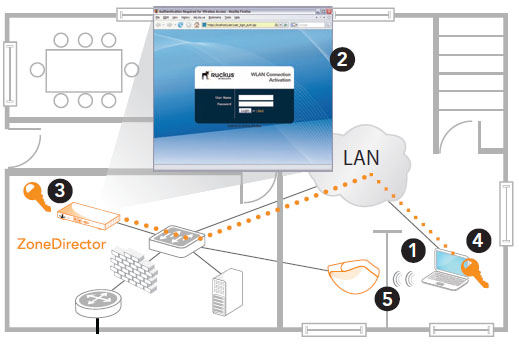
SmartSec
Advanced Security That's Automatic-and Simple.
SmartSec is a unique collection of security capabilities that automates client-side security, making it easy to use. It provides a patent-pending mechanism that generates, configures, and installs encryption keys on client devices—in a process that's totally transparent to the user.
SmartSec features:
- Pre-shared encryption keys
- Role-based user access
- Layer 2/3 client isolation
- Robust link layer encryption
- Wireless intrusion detection
- Industry first Dynamic PSK
- Captive portal authentication
- Automatic guest access
- ActiveDirectory, LDAP, and RADIUS support
Dynamic PSK
Dynamic Pre-Shared Key (PSK) is a patented technology developed to provide robust and secure wireless access while eliminating the arduous task of manual confi guration of end devices and the tedious management of encryption keys.
Dynamic PSK creates a unique 63-byte encryption key for each user upon accessing the wireless LAN for the fi rst time and then automatically configures end devices with the requisite wireless settings (i.e., SSID and unique passphrase) without any manual intervention.
Wireless Security Choice for Enterprises
Wireless security remains a primary concern for enterprises when deploying a WLAN. But securing a WLAN is complex and time consuming. This is a major problem for enterprises with limited IT staff that don't have the time or expertise to implement robust wireless security. Authentication (i.e., who is the user and what is the device) and encryption (the scrambling of data) are the two primary security issues to be addressed.
Three popular security options available tradeoff security and ease of deployment. But none of these options provides an optimal solution.
Wireless Security Options
| Security Opiton | Benefits | Drawbacks |
|---|---|---|
| Open network |
|
|
| Pre-Shared Key |
|
|
| 802.1X |
|
|
| Dynamic PSK |
|
|
While simple to implement, an open wireless network is clearly not a secure solution as it leaves user transmissions in the clear inviting would-be snoopers to easily grab data out of the air or penetrate the internal network.
A more commonly used wireless security option is the common pre-shared encryption key. A key or passphrase is configured on the APs and on every laptop.
While this option is perceived to be more secure, it's not. Using the same PSK for all employees means that key can be easily compromised. The common PSK also tends to be a relatively short string that can be easily compromised. And for every new employee, IT staff must configure the laptop with the SSID and the key. If there's a need to replace the key (e.g., employee leaves), every laptop must be reconfigured.
The third option uses an enterprise-class solution such as 802.1X. Through a highly secure solution, 802.1X is very complex to set up. It requires having the right infrastructure starting with the RADIUS server all the way to 802.1X supplicants on each and every client. Configuring and maintaining 802.1X is time consuming for enterprises that do not have the resources to manage such an endeavor.
A new approach, Dynamic PSK solves these problems.
Dynamic Psk Features and Benefits:
Features:
- Automatic provisioning of unique encryption key to each user/device
- No manual client configuration
- Unique 63-byte key per user per device
- Easily deactivated when employee leaves
- New key can be generated periodically
- Configurable per WLAN
Benefits:
- Robust security simplified
- Highly secure
- "IT Lite" - simple to deploy and maintain
- No expensive AAA or RADIUS servers needed
- Secures handheld devices
How does Dynamic PSK work?
Instead of manually configuring each individual laptop with an encryption key and the requisite wireless SSID, Dynamic PSK automates and centralizes this process.

Dynamic Pre-Shared Key automates secure wireless LAN access
Once enabled for the entire system, a new user simply connects to the Ethernet LAN and authenticates via a captive portal hosted on the RUCKUS ZoneDirector. Mobile devices like the Apple® iPhone® can also be authenticated through a captive portal over wireless. This information is checked against any standard back-end authentication (AAA) server such as Active Directory, RADIUS, LDAP or an internal user database on the ZoneDirector.
Upon successful authentication, the ZoneDirector generates a unique encryption key for each user. The lifetime of the key can be configured to align with company policies. A temporary applet with the unique user key and other wireless confi guration information is then pushed to the client. This applet automatically configures the user's device without any human intervention.
The user then detaches from the LAN and connects to the wireless network. Once associated, the Dynamic PSK is bound to the specific user and the end device being used.
Documentation:
Download the RUCKUS Dynamic PSK Datasheet (PDF).

